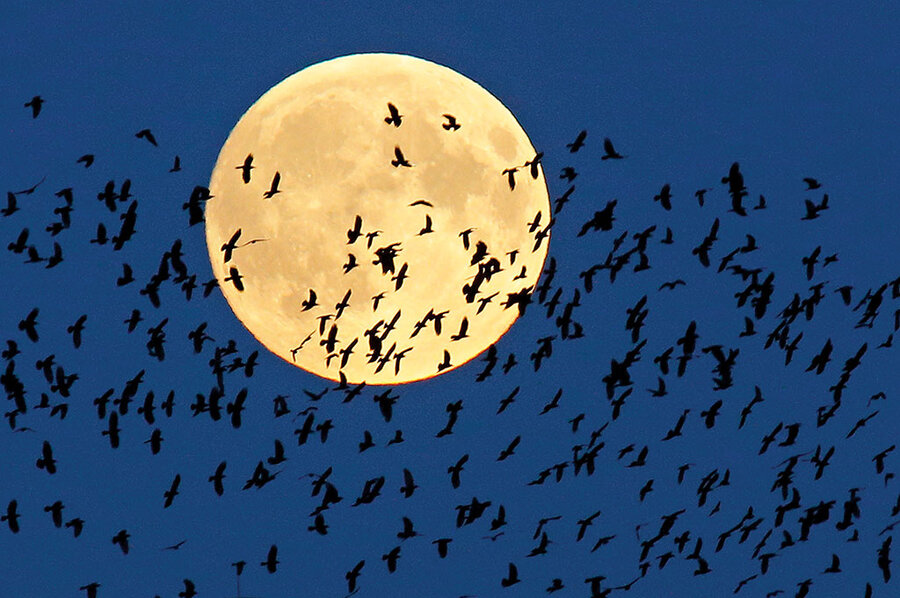An invisible river of birds
Loading...
It’s bedtime, 10 o’clock, but I can’t sleep. Something is tugging me outside on this cool autumn night. I get out of bed, grab a down sleeping bag, and settle into the hammock in the backyard.
Jupiter gleams over the silhouette of a spruce tree at the edge of the field. Constellations shimmer and the Milky Way spills across the sky. Aspen leaves patter in the breeze, then everything falls quiet.
I have spent many warm summer evenings in the hammock, listening to gray tree frogs and a Swainson’s thrush sing in the dusk and watching fireflies until the mosquitoes drove me inside. I would welcome those mosquitoes now, anything to have summer back: the long bright days, peonies in bloom, our woods and fields full of birds. I dread the long months of deepening cold and dark, the leafless trees and snow-slicked roads, the interminable Maine winter.
“Tzeeep?”
A small, high sound nicks the silence. I sit up.
“Tzeeep?” There it is again. “Tzeeep ... chip!”
The sounds are coming from overhead. Flight calls. On this calm, clear night, songbirds are migrating. They utter flight calls, scientists believe, to keep tabs on each other in the dark. I can’t see the birds or tell their flight calls apart, but I know they’re up there: sparrows and thrushes, grosbeaks and buntings, vireos and warblers. Each species has its own distinctive call, most of which are beyond the range of human hearing. I can hear only a tiny fraction of the birds aloft.
Unlike songs, which are lush and loud and all about territory and mating, flight calls are terse, to the point. I imagine the birds’ conversations:
“You there?”
“Yup.”
“Where?”
“Over here.”
“OK.”
I wish I could see all those birds above me, flashy songbirds like indigo buntings and Baltimore orioles, scores of streaky brown song sparrows, and dozens of jewel-toned warblers: northern parulas, black-throated greens, magnolias, and all the rest. I shine a flashlight into the sky. A few white moths flash in the beam, but no birds. They’re too high, flying hundreds or thousands of feet up. I wish I could fly to the tropics with them.
That’s not an option, so I lie here, earthbound, gazing up at the sky. I think about all those birds in the dark, wings beating 20 times per second, their tiny lungs gulping about a hundred breaths a minute.
It surprised me to learn that most songbirds migrate at night, but it makes sense for several reasons. The air is usually calmer, cooler, and more humid at night, which helps prevent overheating and dehydration. It also helps birds avoid predators, such as hawks.
Even more astonishing is that one of the ways birds navigate is by using the stars. Experiments in planetariums have shown that migratory birds in the Northern Hemisphere orient themselves south in the fall and north in the spring using the rotation of stars around a “fixed” point in the sky, which is Polaris, the North Star. The birds reoriented themselves accordingly when scientists used a different star in the planetarium as the point around which the constellations wheeled.
“Peeeep!”
A delicate whistle pierces the night. I’m pretty sure it’s a Swainson’s thrush, whose flight call sounds like a spring peeper. It’s probably not the one I heard this summer, but a traveler from farther north.
Twigs snap. Bushes rustle at the edge of the lawn. My heart races, along with my imagination. Utterly still in my down cocoon, I peer into the dark, my nerves flirting with the unseen and unknown. In a few minutes, the rustling fades into the woods. Deer perhaps, or raccoons, wild neighbors on their evening rounds.
A meteor streaks across the sky. The constellations shift. It’s getting late and I should go back to bed, but not just yet. I hunker into the warmth of my sleeping bag. The stars burn and burn, an invisible river of birds flowing below them.







